Optimal Charging Navigation Strategy Design for Rapid Charging Electric Vehicles
Abstract
1. Introduction
- We design an optimal charging navigation strategy for rapid charging EVs to reduce EV users’ traveling time and charging expenses flexibly.
- We propose an intelligent transport system framework for our optimal charging navigation strategy, while the traffic and power grid operation information are considered.
- To implement our optimal charging navigation strategy, we use the charging power regulation scheme to reduce the influence for power grid, and charging price adjustment scheme to balance the number of EVs at each rapid charging station.
2. System Model
2.1. Rapid-Charging Station
2.2. Intelligent Transport System Center
2.3. EV Terminal
3. Optimal Charging Navigation Scheme
3.1. Time Cost
3.1.1. Driving Time
3.1.2. Waiting Time
3.1.3. Charging Time
3.2. Charging Cost
3.2.1. Rapid Charging Cost
3.2.2. Regular Charging Cost
3.3. Objective Function and Constraints
3.4. Solution
| Algorithm 1Optimal Path Planning Algorithm at slot k. |
Require:
|
4. Simulation Results
4.1. Impact Analysis of the Charging Power Regulation Scheme
4.2. Impact Analysis of the Proposed Rapid Charging Price Adjustment Scheme
4.3. Impact Analysis of the Proposed Optimal Navigation Strategy with Different Weight Coefficient
5. Conclusions
Author Contributions
Funding
Conflicts of Interest
Abbreviations
| EV | Electric Vehicle |
| IoT | Internet of Things |
| V2G | vehicle-to-grid |
| TOU | time-of-use |
| ITS | Intelligent Transport System |
| RCS | Rapid Charging Station |
| DMS | Distribution Management System |
| SoC | State of Charge |
References
- Hannan, M.; Hoque, M.; Mohamed, A.; Ayob, A. Review of energy storage systems for electric vehicle applications: Issues and challenges. Renew. Sustain. Energy Rev. 2017, 69, 771–789. [Google Scholar] [CrossRef]
- Zhang, K.; Mao, Y.; Leng, S.; Zeng, M.; Xu, L.; Jiang, L.; Vinel, A. Optimal energy exchange schemes in smart grid networks: A contract theoretic approach. In Proceedings of the IEEE/CIC International Conference on Communications in China (ICCC), Chengdu, China, 27–29 July 2016; pp. 1–6. [Google Scholar]
- Debnath, U.K.; Ahmad, I.; Habibi, D.; Saber, A.Y. Improving Battery Lifetime of Gridable Vehicles and System Reliability in the Smart Grid. IEEE Syst. J. 2015, 9, 989–999. [Google Scholar] [CrossRef]
- Liu, Y.; Yang, C.; Jiang, L.; Xie, S. Intelligent Edge Computing for IoT-Based Energy Management in Smart Cities. IEEE Netw. 2019, accepted. [Google Scholar]
- De Quevedo, P.M.; Mun̂oz-Delgado, G.; Contreras, J. Joint expansion planning of distribution networks, EV charging stations and wind power generation under uncertainty. In Proceedings of the IEEE Power Energy Society General Meeting, Chicago, IL, USA, 16–20 July 2017; pp. 1–5. [Google Scholar]
- Marcincin, O.; Medvec, Z.; Moldrik, P. The impact of electric vehicles on distribution network. In Proceedings of the 18th International Scientific Conference on Electric Power Engineering (EPE), Ostrava, Czech Republic, 17–19 May 2017; pp. 1–5. [Google Scholar] [CrossRef]
- Yang, H.; Pan, H.; Luo, F.; Qiu, J.; Deng, Y.; Lai, M.; Dong, Z.Y. Operational Planning of Electric Vehicles for Balancing Wind Power and Load Fluctuations in a Microgrid. IEEE Trans. Sustain. Energy 2017, 8, 592–604. [Google Scholar] [CrossRef]
- You, P.; Yang, Z.; Zhang, Y.; Low, S.H.; Sun, Y. Optimal Charging Schedule for a Battery Switching Station Serving Electric Buses. IEEE Trans. Power Syst. 2016, 31, 3473–3483. [Google Scholar] [CrossRef]
- Wang, Y.; Huang, Y.; Xu, J.; Barclay, N. Optimal recharging scheduling for urban electric buses: A case study in Davis. Transport. Res. Part E Logist. Transport. Rev. 2017, 100, 115–132. [Google Scholar] [CrossRef]
- Akhavan-Rezai, E.; Shaaban, M.F.; El-Saadany, E.F.; Zidan, A. Uncoordinated charging impacts of electric vehicles on electric distribution grids: Normal and fast charging comparison. In Proceedings of the IEEE Power and Energy Society General Meeting, San Diego, CA, USA, 22–26 July 2012; pp. 1–7. [Google Scholar]
- Alshareef, S.M.; Morsi, W.G. Impact of fast charging stations on the voltage flicker in the electric power distribution systems. In Proceedings of the IEEE Electrical Power and Energy Conference (EPEC), Saskatoon, SK, Canada, 22–25 October 2017; pp. 1–6. [Google Scholar]
- Febriwijaya, Y.H.; Purwadi, A.; Rizqiawan, A.; Heryana, N. A study on the impacts of DC Fast Charging Stations on power distribution system. In Proceedings of the International Conference on Electrical Engineering and Computer Science (ICEECS), Sanur-Bali, Indonesia, 24–25 November 2014; pp. 136–140. [Google Scholar]
- Wang, K.; Gu, L.; He, X.; Guo, S.; Sun, Y.; Vinel, A.; Shen, J. Distributed Energy Management for Vehicle-to-Grid Networks. IEEE Netw. 2017, 31, 22–28. [Google Scholar] [CrossRef]
- He, Y.; Venkatesh, B.; Guan, L. Optimal Scheduling for Charging and Discharging of Electric Vehicles. IEEE Trans. Smart Grid 2012, 3, 1095–1105. [Google Scholar] [CrossRef]
- Cao, Y.; Tang, S.; Li, C.; Zhang, P.; Tan, Y.; Zhang, Z.; Li, J. An Optimized EV Charging Model Considering TOU Price and SOC Curve. IEEE Trans. Smart Grid 2012, 3, 388–393. [Google Scholar] [CrossRef]
- Xie, S.; Zhong, W.; Xie, K.; Yu, R.; Zhang, Y. Fair Energy Scheduling for Vehicle-to-Grid Networks Using Adaptive Dynamic Programming. IEEE Trans. Neural Netw. Learn. Syst. 2016, 27, 1697–1707. [Google Scholar] [CrossRef] [PubMed]
- Khatiri-Doost, S.; Amirahmadi, M. Peak shaving and power losses minimization by coordination of plug-in electric vehicles charging and discharging in smart grids. In Proceedings of the IEEE International Conference on Environment and Electrical Engineering and 2017 IEEE Industrial and Commercial Power Systems Europe (EEEIC/I CPS Europe), Milan, Italy, 6–9 June 2017; pp. 1–5. [Google Scholar]
- Liu, C.; Zhou, M.; Wu, J.; Long, C.; Wang, Y. Electric Vehicles En-Route Charging Navigation Systems: Joint Charging and Routing Optimization. IEEE Trans Control Syst. Technol. 2017, 27, 906–914. [Google Scholar] [CrossRef]
- Zhu, M.; Liu, X.Y.; Kong, L.; Shen, R.; Shu, W.; Wu, M.Y. The charging-scheduling problem for electric vehicle networks. In Proceedings of the IEEE Wireless Communications and Networking Conference (WCNC), Istanbul, Turkey, 6–9 April 2014; pp. 3178–3183. [Google Scholar]
- Guo, Q.; Xin, S.; Sun, H.; Li, Z.; Zhang, B. Rapid-Charging Navigation of Electric Vehicles Based on Real-Time Power Systems and Traffic Data. IEEE Trans. Smart Grid 2014, 5, 1969–1979. [Google Scholar] [CrossRef]
- Yang, H.; Deng, Y.; Qiu, J.; Li, M.; Lai, M.; Dong, Z.Y. Electric Vehicle Route Selection and Charging Navigation Strategy Based on Crowd Sensing. IEEE Trans. Ind. Inf. 2017, 13, 2214–2226. [Google Scholar] [CrossRef]
- Hafez, O.; Bhattacharya, K. Integrating EV Charging Stations as Smart Loads for Demand Response Provisions in Distribution Systems. IEEE Trans. Smart Grid 2018, 9, 1096–1106. [Google Scholar] [CrossRef]
- Bae, S.; Kwasinski, A. Spatial and Temporal Model of Electric Vehicle Charging Demand. IEEE Trans. Smart Grid 2012, 3, 394–403. [Google Scholar] [CrossRef]
- Gong, Q.; Midlam-Mohler, S.; Serra, E.; Marano, V.; Rizzoni, G. PEV charging control for a parking lot based on queuing theory. In Proceedings of the American Control Conference, Washington, DC, USA, 17–19 June 2013; pp. 1124–1129. [Google Scholar]
- Zhang, X.; Chen, Y.; Li, T. Optimization of logistics route based on Dijkstra. In Proceedings of the 6th IEEE International Conference on Software Engineering and Service Science (ICSESS), Beijing, China, 23–25 September 2015; pp. 313–316. [Google Scholar]
- GACNE Trumpchi GE3 530. 2018. Available online: http://www.gacne.com.cn/vehicles/ge3530 (accessed on 21 December 2018).
- TOU Tariff Standard for Commercial Electricity. 2018. Available online: http://www.docin.com/p-804976213.html (accessed on 21 December 2018).
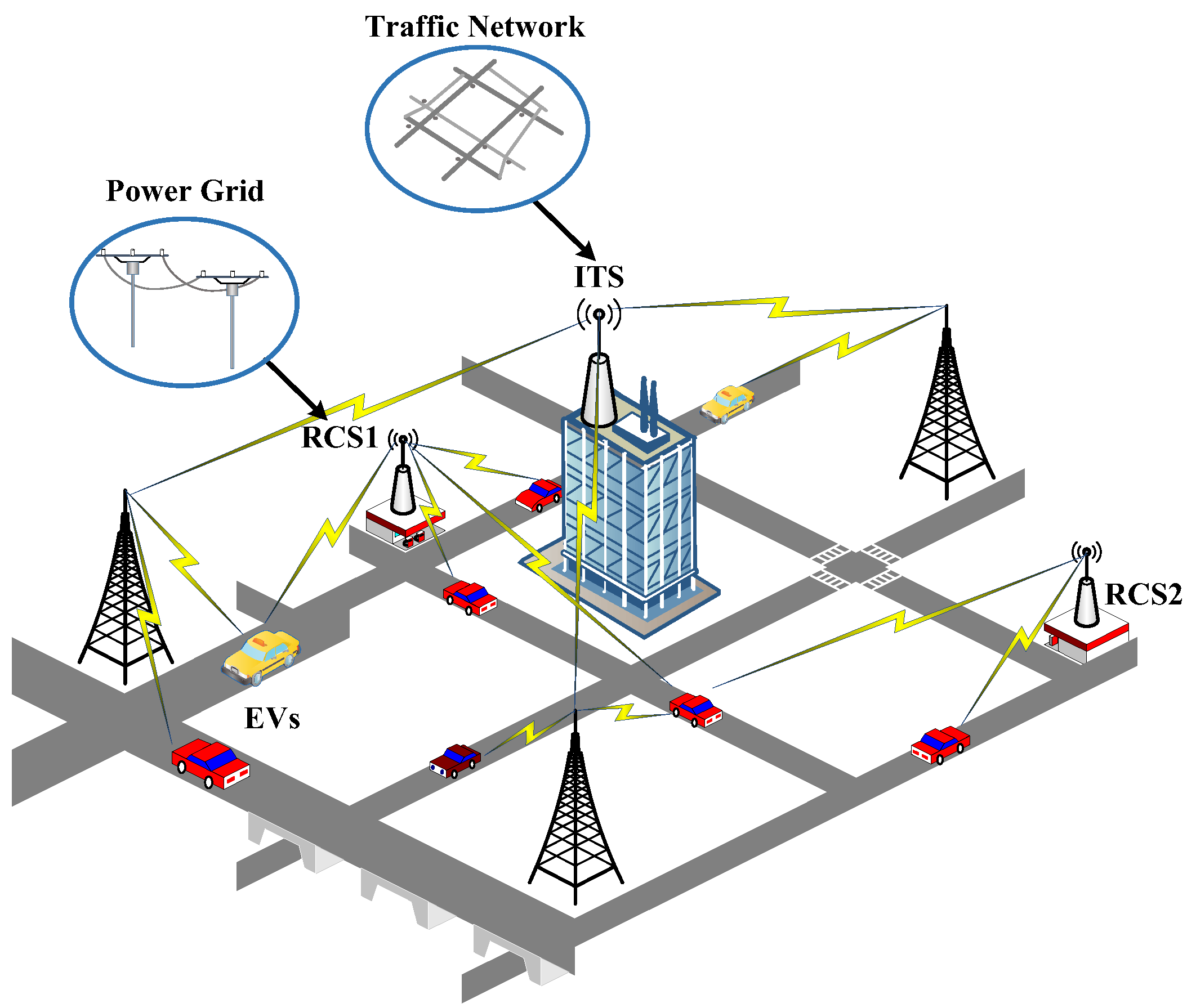

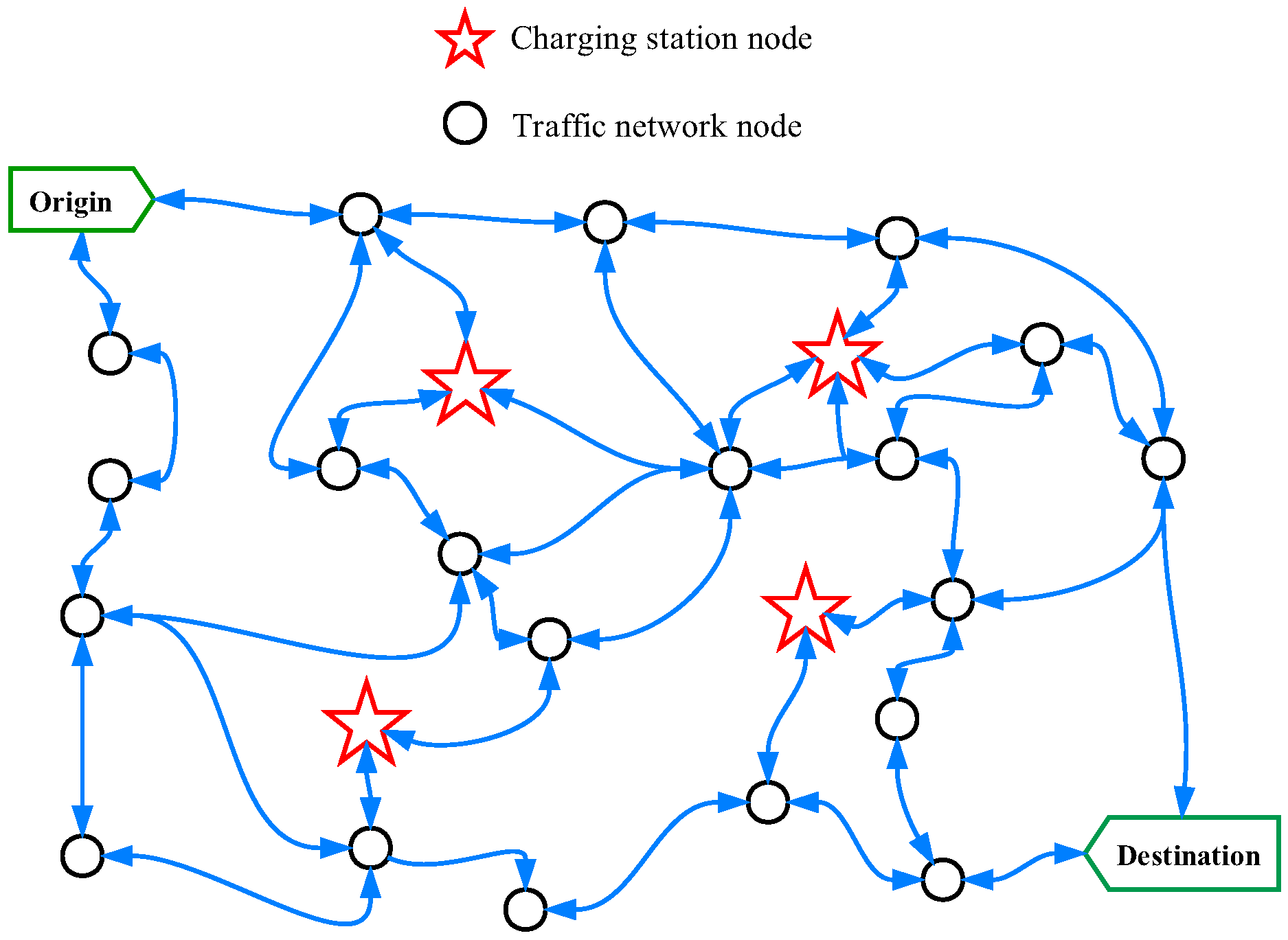
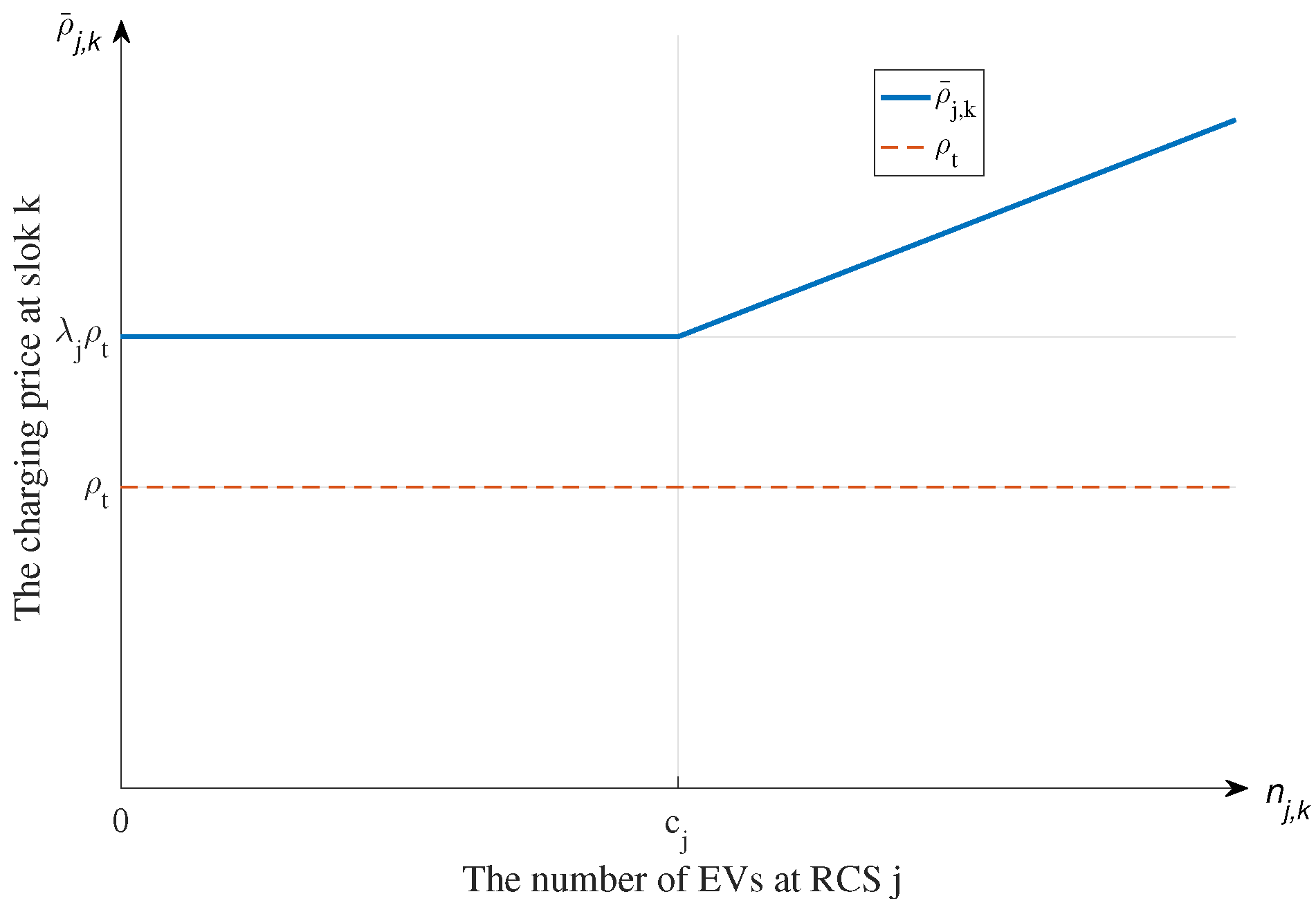
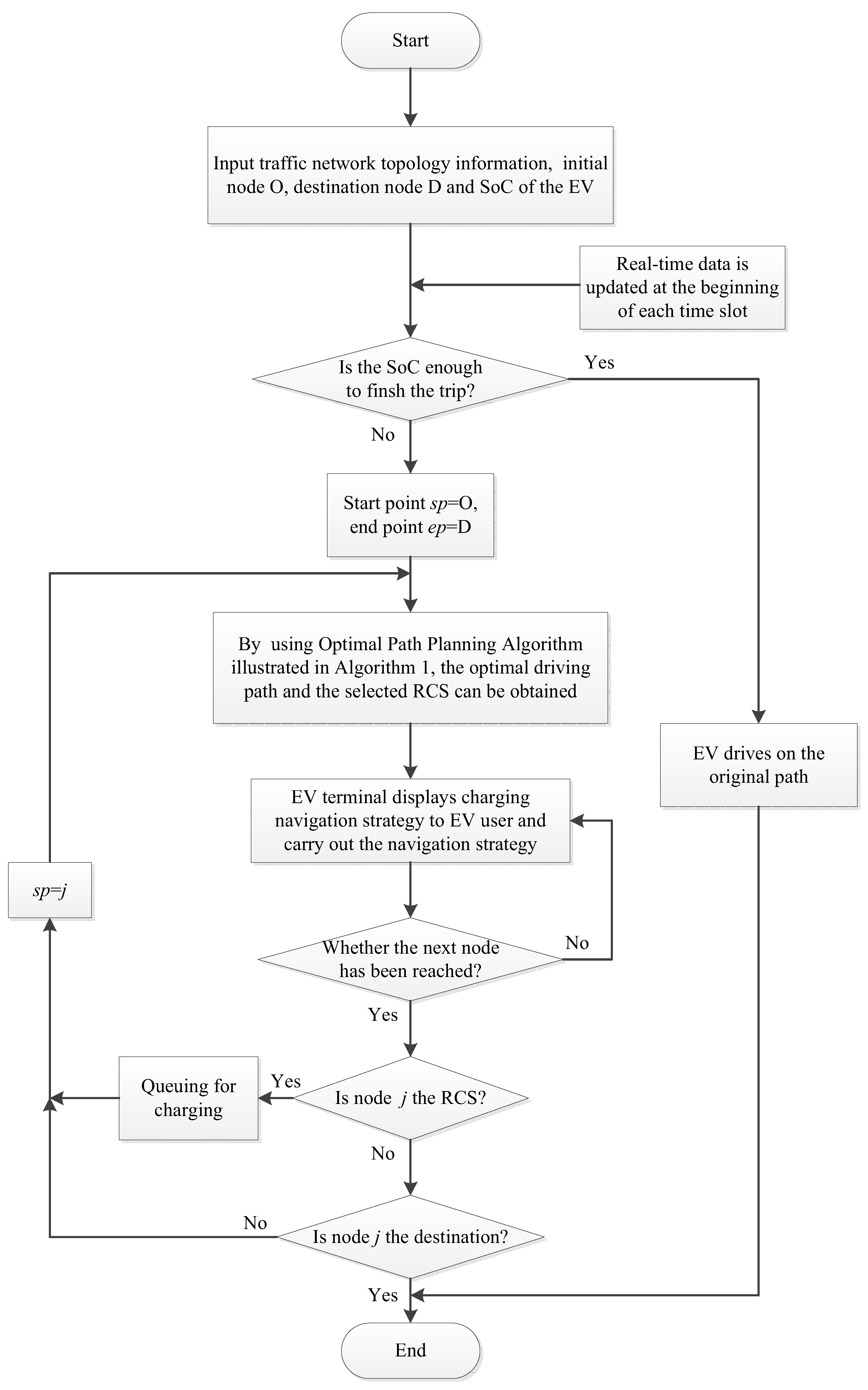
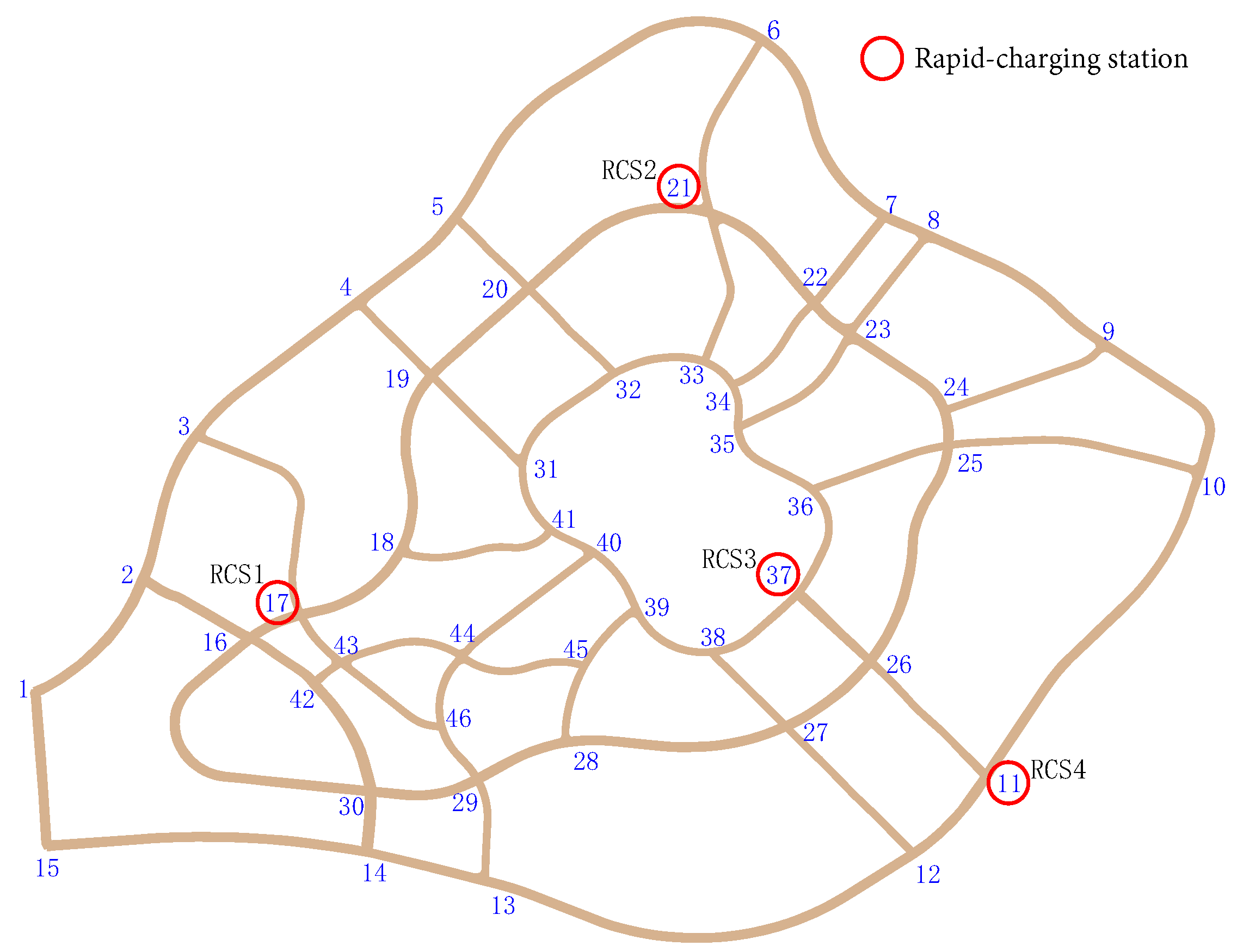
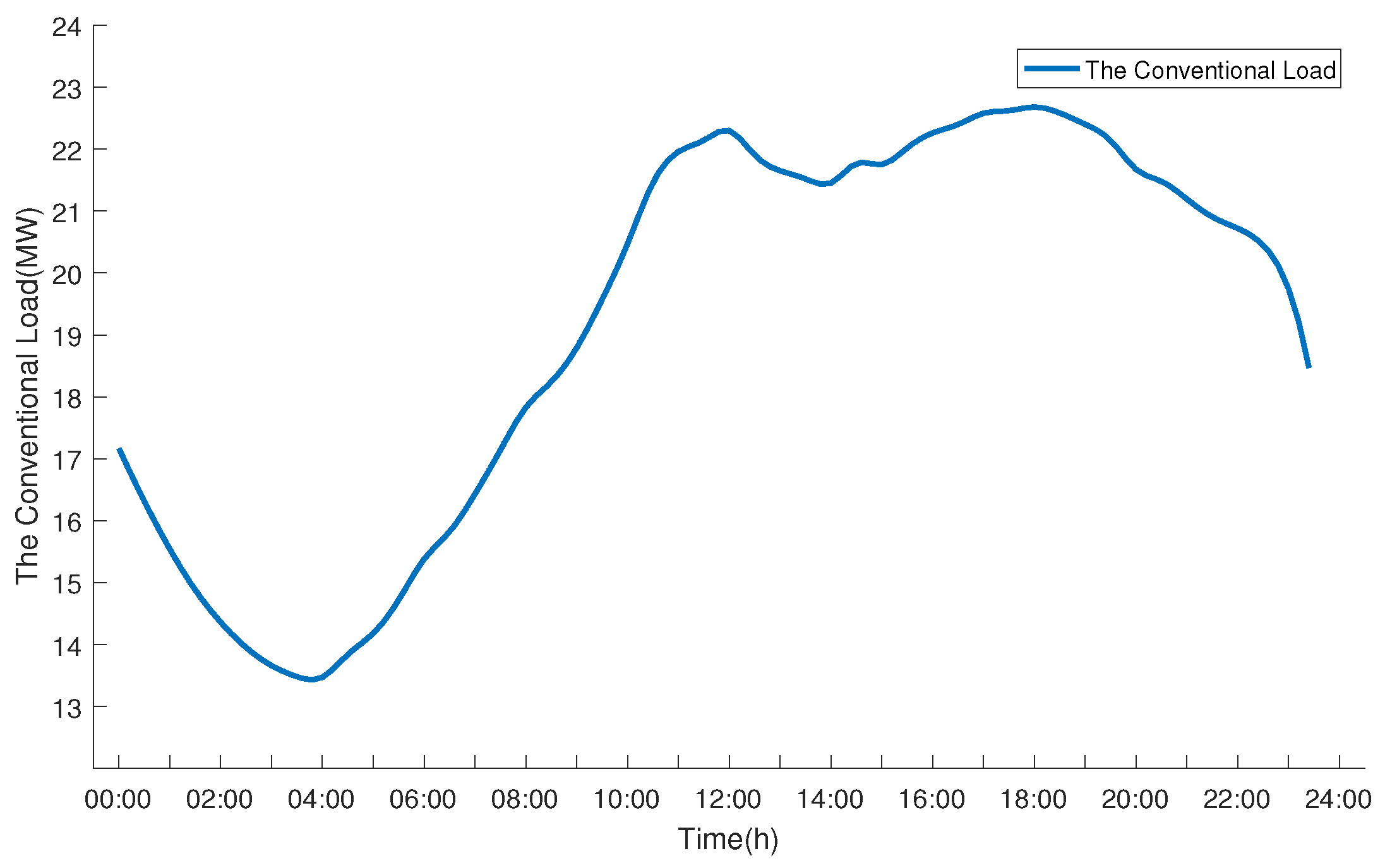
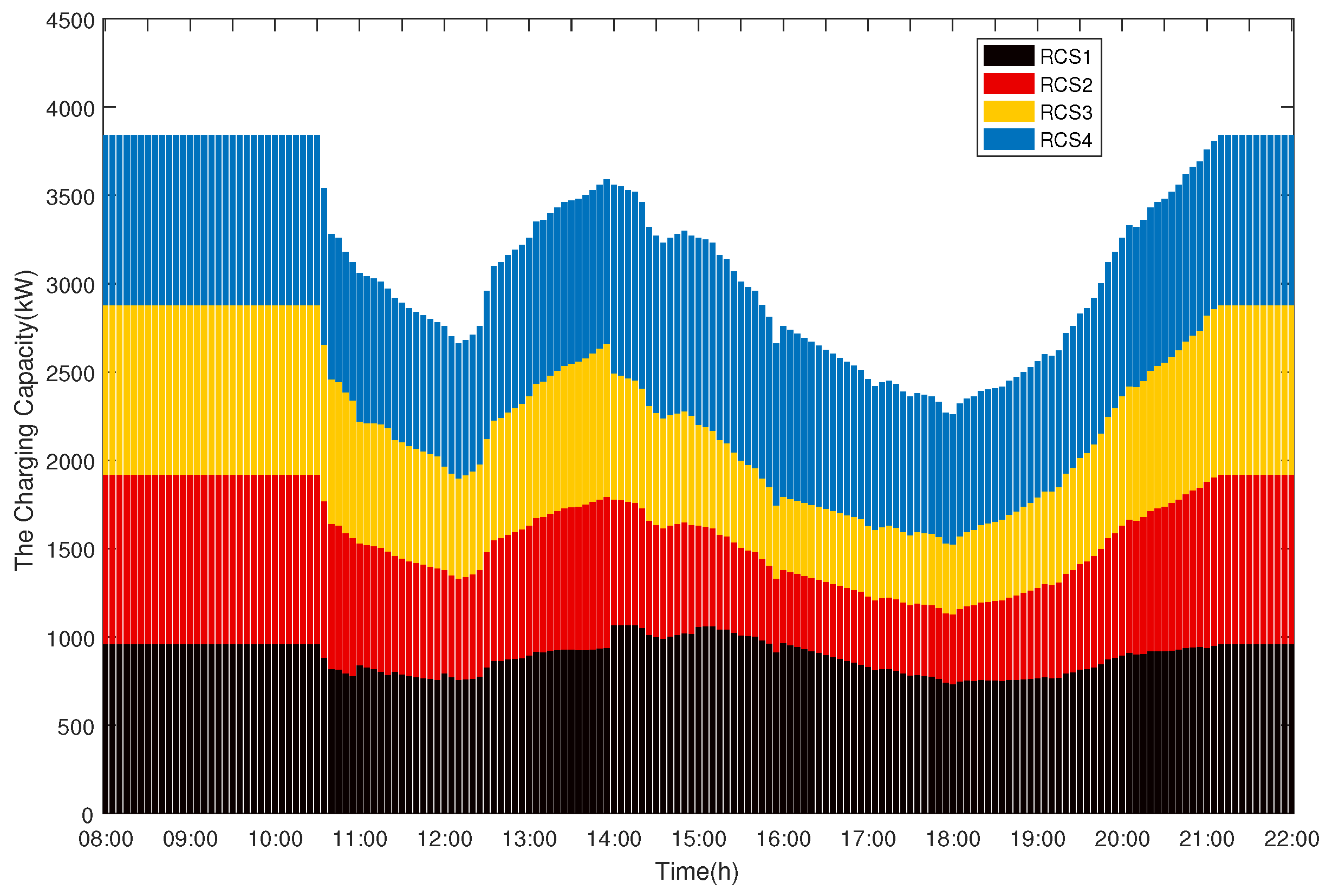
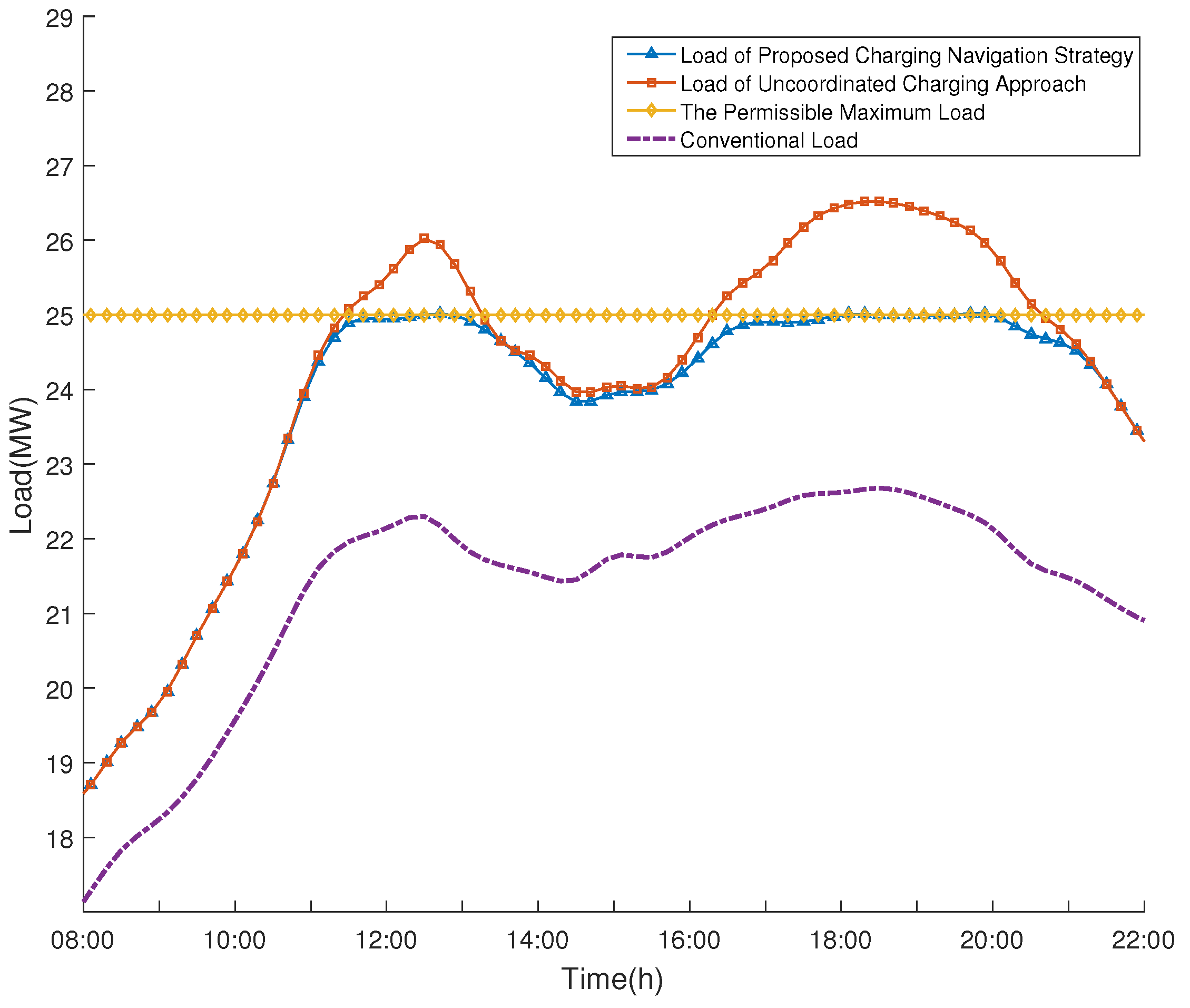
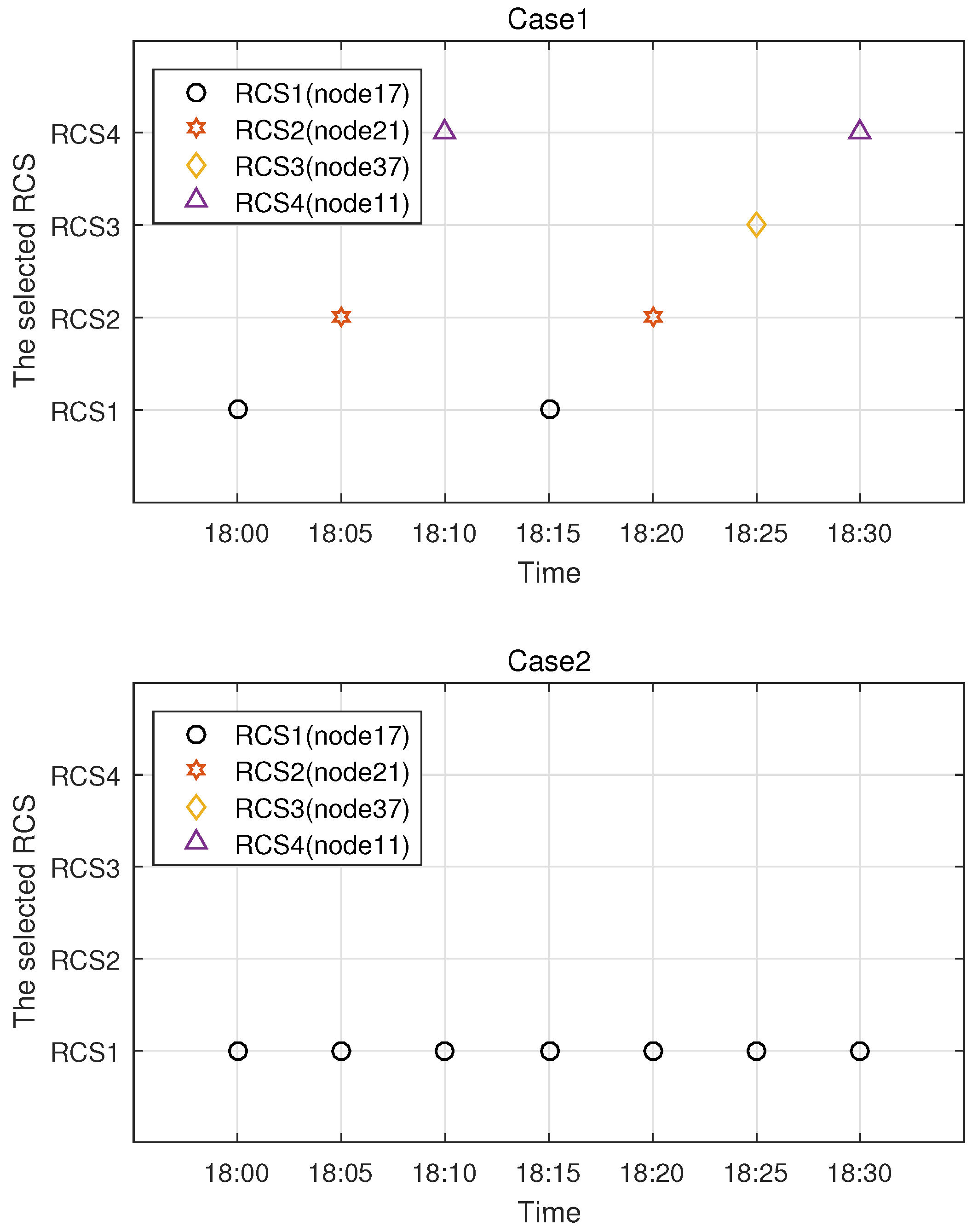
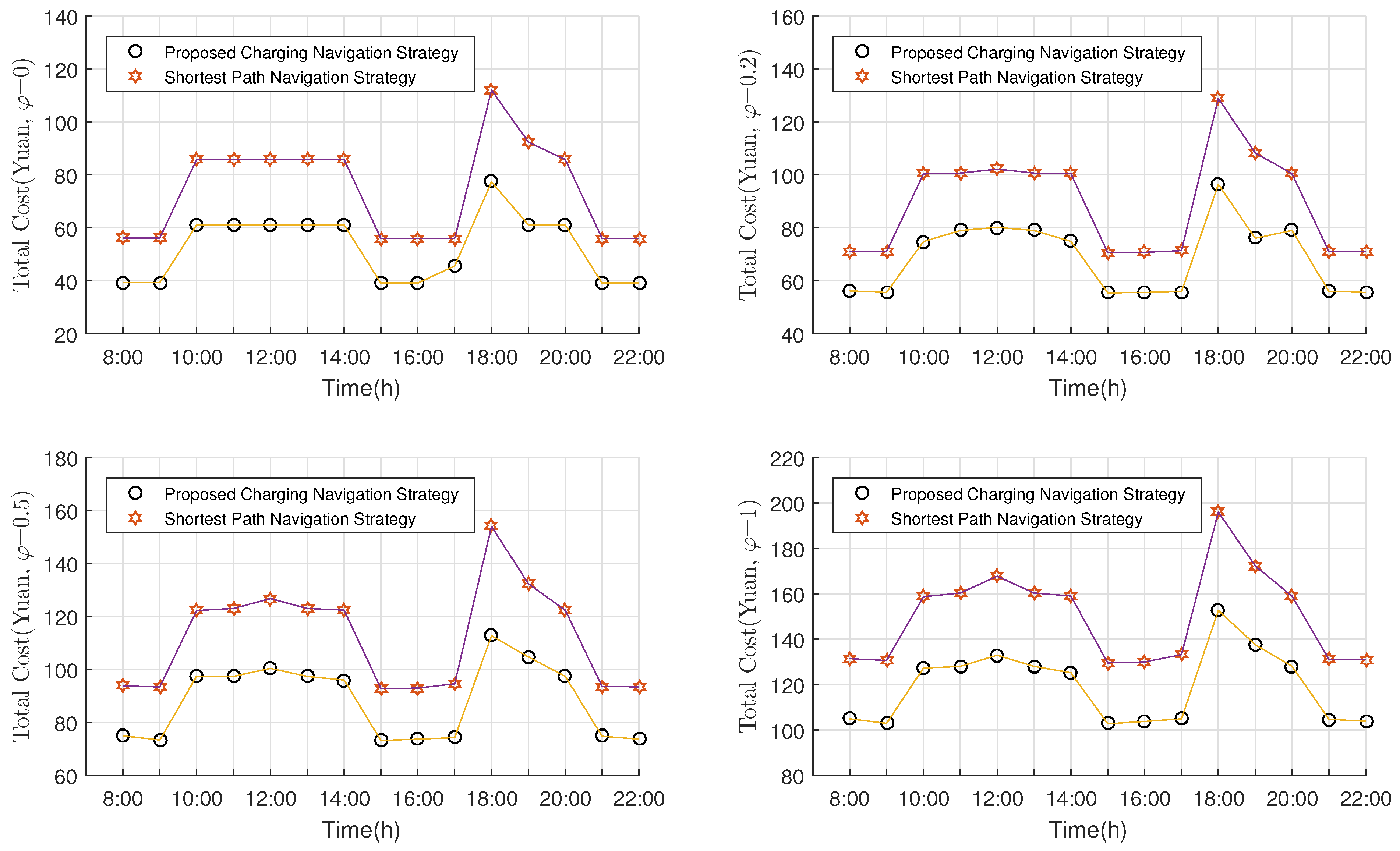

| Symbol | Description |
|---|---|
| Driving/waiting/charging time | |
| Total cost/rapid charging cost/regular charging cost | |
| Weight coefficient | |
| Traveling time between locations i and j | |
| Distance between locations i and j | |
| Average driving velocity between locations i and j during time slot k | |
| At RCS j during time slot k | |
| EVs’ arrival rate (EV number per minute) | |
| EVs’ service rate (EV number per minute) | |
| Occupation rate per charger | |
| Rapid charging power of each charging pole | |
| Charging capacity of RCS j during time slot k | |
| Number of charging EVs | |
| Queuing number of EVs | |
| Rapid charging price | |
| Total number of EV chargers at RCS j | |
| TOU charging price in electricity market(Regular charging price) | |
| Additional charging charges | |
| Rated battery capacity/minimum storage of battery capacity | |
| Rapid charging efficiency | |
| Maximum charging power of charging pole | |
| Battery energy consumption | |
| Rapid charging amount/regular charging amount | |
| State of charge at origin | |
| Driving distance from origin to selected RCS/driving distance from selected RCS to destination |
| Parameter | Values | Parameter | Values |
|---|---|---|---|
| (kWh) | 54.75 | (kWh) | 2.5 |
| (kWh/km) | 0.147 | 0.9 |
| Periods | Bottom | Flat | Peak |
|---|---|---|---|
| (00:00–06:59) (23:00–23:59) | (07:00–09:59) (15:00–17:59), (21:00–22:59) | (10:00–14:59) (18:00–20:59) | |
| (Yuan/kWh) | 0.3818 | 0.8395 | 1.3222 |
| Stations | RCS1 | RCS2 | RCS3 | RCS4 |
|---|---|---|---|---|
| 1.4 | 1.3 | 1.25 | 1.35 | |
| (Yuan/kWh) | 0.15 | 0.15 | 0.15 | 0.15 |
© 2019 by the authors. Licensee MDPI, Basel, Switzerland. This article is an open access article distributed under the terms and conditions of the Creative Commons Attribution (CC BY) license (http://creativecommons.org/licenses/by/4.0/).
Share and Cite
Mo, W.; Yang, C.; Chen, X.; Lin, K.; Duan, S. Optimal Charging Navigation Strategy Design for Rapid Charging Electric Vehicles. Energies 2019, 12, 962. https://doi.org/10.3390/en12060962
Mo W, Yang C, Chen X, Lin K, Duan S. Optimal Charging Navigation Strategy Design for Rapid Charging Electric Vehicles. Energies. 2019; 12(6):962. https://doi.org/10.3390/en12060962
Chicago/Turabian StyleMo, Wangyi, Chao Yang, Xin Chen, Kangjie Lin, and Shuaiqi Duan. 2019. "Optimal Charging Navigation Strategy Design for Rapid Charging Electric Vehicles" Energies 12, no. 6: 962. https://doi.org/10.3390/en12060962
APA StyleMo, W., Yang, C., Chen, X., Lin, K., & Duan, S. (2019). Optimal Charging Navigation Strategy Design for Rapid Charging Electric Vehicles. Energies, 12(6), 962. https://doi.org/10.3390/en12060962





